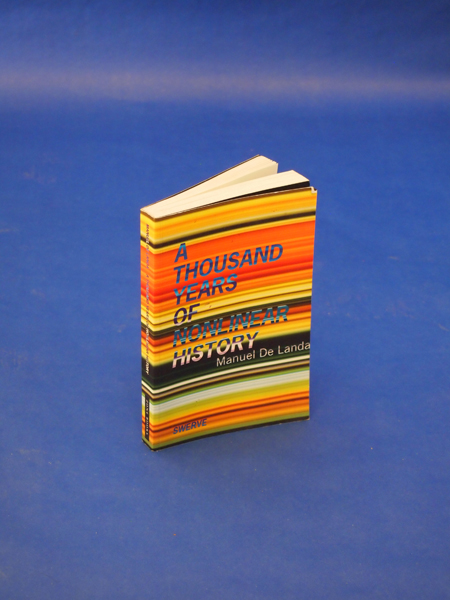![]() body | color | collections | commodity | cube | document | fabric | fetish | gender | glass | home | identity | living | machine | metal | minimal | mobility | narrative | olfactory | organic |
body | color | collections | commodity | cube | document | fabric | fetish | gender | glass | home | identity | living | machine | metal | minimal | mobility | narrative | olfactory | organic |
![]() pain | paper | plastic | plugs | power | protective | rectangular | ritual | round | sound | souvenir | spiritual | style | text-based | time | tool | touch | uniform | value | visual | warm | wood
pain | paper | plastic | plugs | power | protective | rectangular | ritual | round | sound | souvenir | spiritual | style | text-based | time | tool | touch | uniform | value | visual | warm | wood
| Book: A Thousand Years of Nonlinear History | |||
Narrative: A Thousand Years of Nonlinear History By Manuel De Landa, Publisher: Swerve, Printed in USA, ISBN-10: 0942299329 Text for A Thousand Years of Nonlinear History was typeset and the mechanical copy of the manuscript was sent to a printer. The vendor then photographed the pages to produce page negatives. Next, negatives were stripped by hand onto large flat sheets known as 'goldenrods,' and the goldenrods were exposed with ultraviolet light. This resulted in 'blueprints," a positive reproduction of the book that is then checked for accuracy. The paper was made from pulp obtained by chemical means, known as kraft pulping. Chips of wood were placed in a large, sealed container known as a digester. The digester contained a strongly alkaline solution of sodium hydroxide and sodium sulfide. Bleaching removes lignin and involves mixing the pulp with a series of oxidizing chemicals that react with the lignin. After each mixture, the pulp is washed with an alkaline solution that removes the treated lignin. Fillers are added to the pulp. A typical filler is a clay known as kaolin. Other chemicals often added to pulp include starches or gums. Rosin (a substance derived from pine trees) and alum (aluminum sulfate) are often added as sizers, making the paper less absorbent. Pulp is added to water to form slurry in order to make paper with an even density. The slurry is pumped onto a moving mesh screen made up of very fine wires of metal or plastic. Water drains through the small openings in the mesh, forming a sheet of wet material from the slurry. The sheet is moved on a series of belst made of felt containing wool, cotton, and synthetic fibers. The dried sheets move between rollers known as calendars to make it smooth. After the typeset version of the book was reviewed and necessary changes made, it was printed and bound with the cover, resulting in a finished book. The typesetting and printing consists of filming and all subsequent steps are typically done by specialized vendors. Book binding also involves sewing the signatures together, gluing the spine, and inserting lining and trimming the edges. Finally the book is enclosed in a cover. I purchased this used book through Amazon.com after reading a syllabus for an architecture class at NYU that included the book during the summer of 2008. The cost was 9.95 + 3.99, and have had it in Queens, Manhattan, and moved it to Brooklyn.
|
 |
||
![]()
